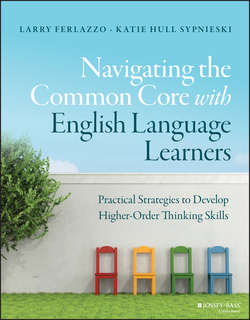Читать книгу Navigating the Common Core with English Language Learners - Sypnieski Katie - Страница 12
На сайте Литреса книга снята с продажи.
Chapter One
English Language Learners and the Common Core: An Overview
Adolescent English Language Learners and Long-term ELLs
ОглавлениеThe adolescent English learner population in this country is growing fast and contains students from a variety of linguistic, cultural, and educational backgrounds.19
Newcomer or refugee students represent a small, but highly vulnerable subgroup of the adolescent English learner population.20 While some of these students come with high literacy skills and content knowledge, many have had interrupted formal education in their home countries. These students enter U.S. schools with limited educational experiences and lower levels of literacy in their home languages.
A larger number of adolescent ELLs were born in the United States, are second- or even third-generation immigrants, and have been enrolled in U.S. schools since kindergarten.21
One out of every four children in the United States is an immigrant or the U.S. – born child of immigrants.22
Nationwide 82 % of current ELL students in grades K–5 are native-born, and 55 % of ELLs in grades 6–12 were born in the United States.23
Researchers have identified secondary ELL students who have attended school in the United States for 6 years or more,24 but who continue to require language support services in school as long-term English language learners, LTELs, or LTELLs.25 Many of these students have developed high levels of oral proficiency, but lack academic language and literacy skills needed to master subject matter. They often remain “stuck” at the intermediate level of proficiency and face disproportionately high dropout rates.26 LTELs comprise approximately one third of all secondary ELLs in both New York City public schools and Chicago Public Schools. In Colorado, 23 % of secondary ELLs are LTELs, and 59 % in 40 school districts in California are considered LTELs.27 However, despite the large number of these students in many schools and districts across the country, LTELs often represent an “invisible population” because of a lack of research on their particular experiences and a lack of programs in schools designed to meet their specific needs.28
California researchers, educators, and legislators have been in the forefront of calling attention to the needs of LTELs, particularly the organization Californians Together, led by Dr. Laurie Olsen (http://www.californianstogether.org). According to Californians Together, three out of four (74 %) English learner students in grades 6–12 have been in California schools for 7 years or more and have still not attained proficiency in English. Of this group, 19 % of secondary ELLs meet the state's multiple criteria that designate them as Long-term English Learners (7 years or more in California schools, scoring Far Below Basic or Below Basic on the state academic exams in English Language Arts and failing to progress on the state's English language proficiency exam).29
In 2010, Californians Together published Reparable Harm: Fulfilling the Unkept Promise of Educational Opportunity for California's Long Term English Learners, which contains a wealth of research, recommendations, and resources on LTELs.30
As a result of new legislation passed in 2012,31 California is making an effort to identify students who are currently long-term ELs and those who are “at risk” of becoming LTELs in order to provide them with the educational support they need. The law also requires that the Department of Education provides school and district level data annually on those students who are, or are at risk of becoming long-term ELLs.32
19
http://www.ascd.org/publications/educational-leadership/mar07/vol64/num06/Focus-on-Adolescent-English-Language-Learners.aspx
20
Short, D.J., & Boyson, B.A. (2012). Helping newcomer students succeed in secondary school and beyond. Washington, DC: Center for Applied Linguistics.
21
National Education Association. (n.d.). English Language Learners face unique challenges. Retrieved from http://www.nea.org/assets/docs/HE/ELL_Policy_Brief_Fall_08_(2).pdf
22
Tamer, M. (2014, December 11). The education of immigrant children. Harvard Graduate School of Education. Retrieved from https://www.gse.harvard.edu/news/uk/14/12/education-immigrant-children
23
Hill, L. (2012, September). California's English learner students. Public Policy Institute of California. Retrieved from http://www.ppic.org/main/publication_quick.asp?i=1031
24
Long-term English learner. (n.d.). The glossary of education reform. Retrieved from http://edglossary.org/long-term-english-learner/
25
Menken, K., Kleyn, T., & Chae, N. (2012). Spotlight on “long-term English Language Learners”: Characteristics and prior schooling experiences of an invisible population. International Multilingual Research Journal, 6, 121–142. Retrieved from https://katemenken.files.wordpress.com/2011/10/menken-kleyn-chae-2012-spotlight-on-e2809clong-term-english-language-learnerse2809d-imrj1.pdf
26
Olsen, L. (2010). Reparable harm: Fulfilling the unkept promise of educational opportunity for California's long term English learners. Californians Together. Retrieved from http://www.niddk.nih.gov/health-information/health-topics/diagnostic-tests/thyroid-tests/Pages/default.aspx#hcp
27
Menken, K., Kleyn, T., & Chae, N. (2012). Spotlight on “long-term English Language Learners”: Characteristics and prior schooling experiences of an invisible population. International Multilingual Research Journal, 6, 121–142 (p. 122). Retrieved from https://katemenken.files.wordpress.com/2011/10/menken-kleyn-chae-2012-spotlight-on-e2809clong-term-english-language-learnerse2809d-imrj1.pdf
28
Olsen, L. (2010). Reparable harm: Fulfilling the unkept promise of educational opportunity for California's long term English learners (p. 7). Californians Together. Retrieved from http://www.niddk.nih.gov/health-information/health-topics/diagnostic-tests/thyroid-tests/Pages/default.aspx#hcp
29
California is the first state in the nation to define and identify English learners who after many years are struggling to succeed. (2015, January 5). Californians Together. Retrieved from http://www.ciclt.net/sn/adm/editpage.aspx?ClientCode=calto&Filename=Website.txt
30
Olsen, L. (2010). Reparable harm: Fulfilling the unkept promise of educational opportunity for California's long term English learners. Californians Together. Retrieved from http://www.niddk.nih.gov/health-information/health-topics/diagnostic-tests/thyroid-tests/Pages/default.aspx#hcp
31
AB-2193 Long term English learners. (2011–2012). California Legislative Information. Retrieved from http://leginfo.legislature.ca.gov/faces/billNavClient.xhtml?bill_id=201120120AB2193
32
Reports. (2014, December 17). Californians Together. Retrieved from http://www.californianstogether.org/reports/
